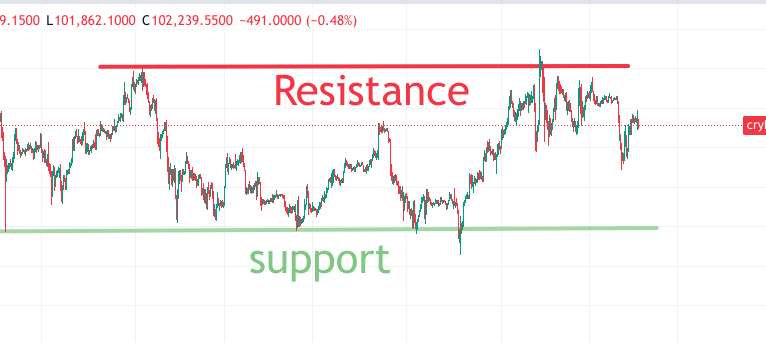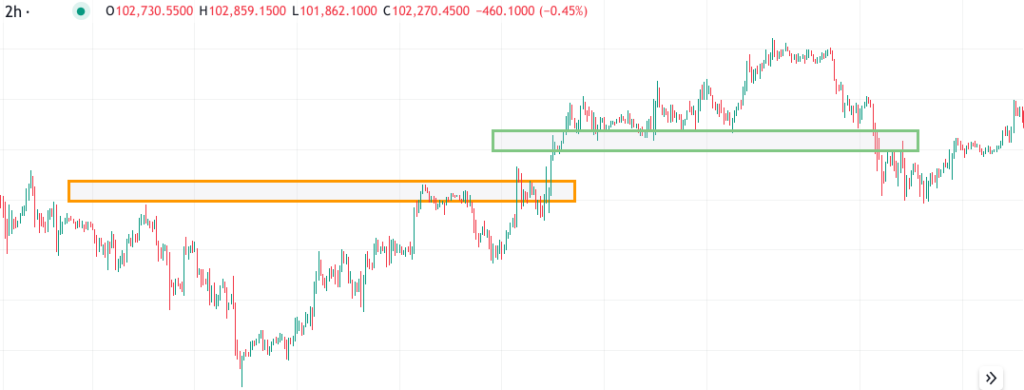Understanding Support and Resistance in Cryptocurrency
Discover the value of support and resistance in cryptocurrency trading. Learn how to recognise and apply these important levels to make more educated trading decisions and increase your earnings.

Introduction to Support and Resistance in Crypto:
Support and resistance are two key principles in cryptocurrency trading. They are the levels at which a cryptocurrency’s price is expected to bounce back or break through, and knowing how to recognise and use them will help you make more educated trading decisions.
The idea of support and resistance in cryptocurrency will be discussed in this post, along with definitions, techniques to spotting them, and applications for trading choices. Along with offering advice and techniques for making the most of these effective tools, we will also go over typical blunders to avoid when utilising resistance and support.
What is Support and Resistance?
Support and resistance levels on a chart indicate where the price of a cryptocurrency is likely to face opposition or support.The price is expected to find resistance and may reverse at a level known as resistance whereas support is a level at which the price is likely to rebound.
For instance, Nine Thousand Dollars is a level of support if the price of Bitcoin is now at Ten Thousand Dollars and has previously recovered from Nine Thousand Dollars as well. On the other side if the price of Bitcoin is trading at Ten Thousand Dollarsand has previously been rejecte at Eleven Dollars then is a resistance level. Eleven Thousand Dollars
Types of Support and Resistance Levels:
There are several types of support and resistance levels, including:
1) Horizontal support and resistance levels:
These are levels at which the price has previously bounced back or broken through.
2) Trendline support and resistance levels:
These are levels at which the price is likely to encounter opposition or support based on the trend of the market.
3) Fibonacci support and resistance levels:
These are levels at which the price is likely to encounter opposition or support based on Fibonacci ratios.
How to Identify Support and Resistance Levels in Crypto:

Identifying support and resistance levels in crypto can be done using a variety of technical analysis tools, including:
1) Chart patterns:
Such as head and shoulders, triangles, and wedges.
2) Trendlines:
Such as uptrend lines and downtrend lines.
3) Fibonacci levels:
Such as 23.6%, 38.2%, and 61.8% retracement levels.
For Example:
If you look at an Ethereum chart and see that the price has already rebounded back from two hundred dollars, then two hundred dollars is a level of support. You may also use trendlines to determine support and resistance levels. For example, if you create an uptrend line on a Bitcoin chart and it crosses with the price at ten thousand dollars it represents a level of support.
Using Support and Resistance to Make Trading Decisions:
Support and resistance levels can be used to make informed trading decisions, including:
1) Buying and selling:
Support and resistance levels can be used to determine when to buy or sell a cryptocurrency.
2) Setting stop-losses:
Support and resistance levels can be used to set stop-losses and limit potential losses.
3) Setting take-profits:
Support and resistance levels can be used to set take-profits and lock in profits.

For Example:
If you look at a Bitcoin chart and see that the price is reaching a level of resistance at eleven thousand dollars, you could want to sell your Bitcoin or place a stop-loss at ten thousand five hundred On the other hand, if you see that the price is nearing a level of support at nine thousand dollars, you should consider purchasing Bitcoin or establishing a take-profit target of a hundred thousand dollars
Common Mistakes to Avoid When Using Support and Resistance:
There are several common mistakes to avoid when using support and resistance, including:
1) Not using multiple time frames:
upport and resistance levels can be different on different time frames, and using multiple time frames can help to identify the most important levels.
2) Not using other technical analysis tools:
Support and resistance levels should be used in conjunction with other technical analysis tools, such as chart patterns and trendlines.
3) Not adjusting for market conditions:
Support and resistance levels can be affected by market conditions, such as volatility and liquidity, and adjusting for these conditions can help to improve the accuracy of trading decisions.
For Example:
If you’re looking at an Ethereum chart and see that the price is reaching a level of resistance at two hundred dollars, you might consider utilising additional technical analysis tools, like as the relative strength index (RSI), to determine whether the price is likely to break through the barrier level.
Conclusion:
In conclusion, support and resistance are useful tools for making educated cryptocurrency trading decisions. Traders who understand how to recognise and exploit these levels can boost their chances of success and maximise their earnings. To get the most out of support and resistance, employ several time frames and other technical analysis tools, as well as modify for market conditions. With practice and expertise, you may become a great trader and take advantage of the chances in the cryptocurrency market.
